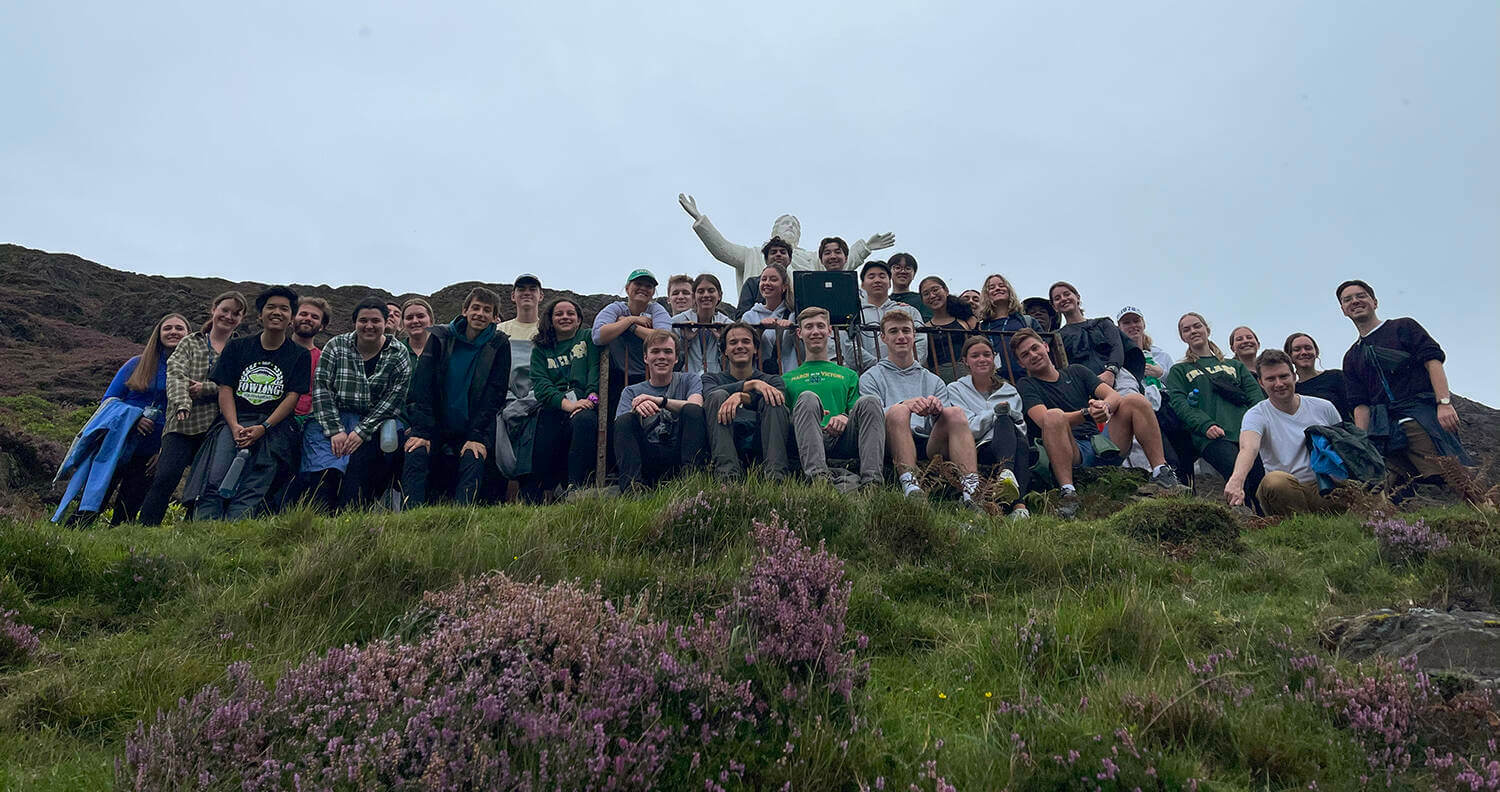Notre Dame Dublin campus minister challenges students to study abroad as a pilgrimage, not tourism
 Fall 2023 Dublin students hiking on the Kylemore Abbey grounds.
Fall 2023 Dublin students hiking on the Kylemore Abbey grounds.After the buzz of the Notre Dame vs. Navy football game in the Aviva Stadium in Dublin, fifty Notre Dame juniors piled into a bus to spend a week in Connemara, in the west of Ireland.
The group was still new, so conversations mostly floated on the surface and skimmed along common ground. Fresh off a Notre Dame victory and bubbling with excitement at the beginning of their semester abroad, the students were ready to tackle upcoming months.
I remember the exact feeling; I started a yearlong study abroad at Trinity College Dublin with a Notre Dame football game against Navy in the Aviva Stadium as well.
Despite any other issues or misfortunes during the season, denying the impact of a Notre Dame victory in Ireland is hard.
If you asked certain students, they would have told you that misfortune had quickly befallen the group. The bus dropped us all off at the foot of Croagh Patrick, and we were going to climb to its peak. Faces paled; people were not ready to start the climb. The excitement from the bus ride had vanished. Although, after blood, sweat, and tears (and maybe not in just that order), we reached the top.
Croagh Patrick has been a religious site for centuries, and most famously, a pilgrimage site for St. Patrick and the thousands of pilgrims who follow in his footsteps.
Less than one week into their program, the students had already completed one of the most famous pilgrimages in Ireland. The silence on the bus screamed of everyone’s tiredness. Yet, they were only just realizing that they were starting another pilgrimage.
The geographical pilgrimage is the symbolic acting out of an inner journey.
Thomas Merton writes, “The geographical pilgrimage is the symbolic acting out of an inner journey. The inner journey is the interpolation of the meaning and signs of the outer pilgrimage. One can have one without the other. It is best to have both.”
The hike up Croagh Patrick was a physical pilgrimage, yet it was also mental and spiritual. People realized limits; others smashed what they thought they were capable of. Everyone accomplished a task that was difficult and some thought improbable.
We could use this pilgrimage journey as a lens. The students’ trips (to, in, and around Ireland) are also pilgrimages to enhance their views of themselves and the world around them. In this enhancement of view, perspectives will focus on the aspects that truly matter.
Over the semester the physical pilgrimages have created interior ones. Students left dinner early to run through a small Irish town to get to Mass on time. Students work weekly with migrants and refugees in Ireland on different academic subjects through ND Dublin's Community Based Learning program. Students volunteer at after school programs and earn nicknames from the Irish youth. (As a former middle school teacher, I can attest: nicknames are badges of honor.) One student is helping O’Connell House reassess energy consumption, and others are tackling major discussions and issues in research through classes.
As an academic institution, Notre Dame prides itself on the caliber of its students and their academic achievements. It is just as important, and maybe even more, to marvel at the achievements that fall under other categories: ethical, moral, communal.
The Notre Dame Mission Statement says that the University’s “aim is to create a sense of human solidarity and concern for the common good that will bear fruit as learning becomes service to justice.” So many institutions can teach textbook or professional skills, but blending them with a human experience and communal outlook is a more unique experience.
Hiking Croagh Patrick allowed the students to look back at the Irish countryside with a bird’s eye view. That vantage point leaves people breathless. But it also shows the world from a new angle. Mountains and hills seem smaller and rivers and lakes come into view. The pilgrimage of this semester has refocused the vantage point of the world and self.
The climax of a work of fiction is when the protagonist finally sees things in an “a-ha!” moment and then can act on this information. In the Bible, Jesus consistently had his disciples rethink what they knew about their world, their neighbors, and themselves. (I am thinking about the dropping of the stones and “The Good Samaritan”.) Each pilgrimage every student has taken this semester is in itself an “a-ha!” moment even if the realizations only seep from the subconscious in a few years or more.
It has been an honor seeing the work, ideas, and growth of the Notre Dame students studying in Dublin, all bubbling up from “a-ha” moments. The students have embraced the physical pilgrimage in a way that has bore interior fruit. They have spoken eloquently on projects that have inspired discernment, whether in law, education, the environment, or political science. Many can see areas where they can leave their marks through positive changes or influence.
I urge you, when possible, to take a walk, a hike, or move yourself beyond your normal vantage point. Seeing the world anew helps you to see yourself anew.
When I lived in Pensacola, Florida, standing on the shore gazing at the Gulf helped change my perspective. In South Bend, the dome-view window on the 8th floor in Hesburgh gave me new insight. And here in Dublin, climbing the Smithfield Tower has helped me re-see the world and myself.
St. Patrick went up Croagh Patrick to pray and reflect, much like Moses on Mount Sinai. This time of isolated prayer and reflection provided St. Patrick with unique promises from God, and our students have been enacted into a new sense of being.
Imagine what we can do for the world when we do the same.